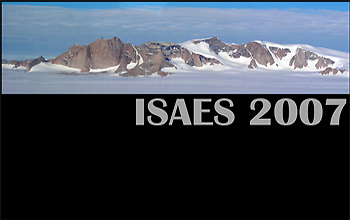Media Advisory 07-024
Media Panel to Explain Latest Developments in Antarctic Earth Sciences
Subglacial lakes, 5-million year old paleoclimate record among topics to be discussed; A live webcast will be available

The International Symposium on Antarctic Earth Science convenes every four years.
August 30, 2007
This material is available primarily for archival purposes. Telephone numbers or other contact information may be out of date; please see current contact information at media contacts.
Several leading U.S. scientists who specialize in Antarctica will brief the media about the latest earth-science research on the southernmost continent as part of a major international conference. The briefing is one of many activities during the International Polar Year (IPY).
| What: | Media briefing as part of the International Symposium on Antarctic Earth Science (ISAES), a major international Antarctic geoscience meeting, convened once every four years. |
| When: | Friday, Aug. 31, 2007, at 3:30 p.m. (Pacific time) |
| Who: | Robin Bell, Lamont-Doherty Earth Observatory at Columbia University; Paul Fitzgerald, Syracuse University; Ross Powell, Northern Illinois University; Samuel Mukasa, University of Michigan |
| Where: | Corwin Pavillion, University of California, Santa Barbara |
| Background: | ISAES, sponsored by the Scientific Committee on Antarctic Research and the U.S. National Science Foundation (NSF), is being held this week at the University of California, Santa Barbara. Scientists presenting at the conference will discuss significant developments in the field and answer questions from the news media during Friday's briefing. |
Topics to be discussed in the media briefing, which also will serve as a conference wrap-up session, include:
• An overview of Antarctic earth science in the context of IPY. IPY is concerted campaign of science in the polar regions that began in March 2007. NSF is the lead U.S. agency for IPY.
• A public presentation of paleoclimate data amassed by the Antarctic Geologic Drilling project (ANDRILL). ANDRILL sediment cores provide a climate record of the past 5 million years.
• Research into the vast system of subglacial lakes and rivers only recently discovered beneath Antarctica's ice sheets. The presentation will touch on efforts to explore the lakes in the context of a recent report on the safest way to proceed with this science recently issued by the National Academies of Science.
• A discussion of the newest research into the question of how Antarctica broke away from a larger landmass millions of years ago to become the isolated and frigid continent it is today.
The media briefing will be webcast live here: http://www.it.id.ucsb.edu/isaes.mov
Media who wish to interview panelists should contact Gail Gallessich, at the University of California, Santa Barbara, at (805) 893-7220 or (805)680-2592 (cell)
-NSF-
Media Contacts
Peter West, NSF, (703) 292-7761, email: pwest@nsf.gov
Gail Gallessich, University of California, Santa Barbara, (805) 893-7220, email: gail.g@ia.ucsb.edu
B-Roll Contacts
Dena Headlee, NSF, (703) 292-7739, email: dheadlee@nsf.gov
Related Websites
U.S. Government Web Portal for the International Polar Year: http:www.ipy.gov
International Symposium on Antarctic Earth Sciences (ISAES) Web site: http://isaes2007.geol.ucsb.edu/
The U.S. National Science Foundation propels the nation forward by advancing fundamental research in all fields of science and engineering. NSF supports research and people by providing facilities, instruments and funding to support their ingenuity and sustain the U.S. as a global leader in research and innovation. With a fiscal year 2023 budget of $9.5 billion, NSF funds reach all 50 states through grants to nearly 2,000 colleges, universities and institutions. Each year, NSF receives more than 40,000 competitive proposals and makes about 11,000 new awards. Those awards include support for cooperative research with industry, Arctic and Antarctic research and operations, and U.S. participation in international scientific efforts.
Connect with us online
NSF website: nsf.gov
NSF News: nsf.gov/news
For News Media: nsf.gov/news/newsroom
Statistics: nsf.gov/statistics/
Awards database: nsf.gov/awardsearch/
Follow us on social
Twitter: twitter.com/NSF
Facebook: facebook.com/US.NSF
Instagram: instagram.com/nsfgov


